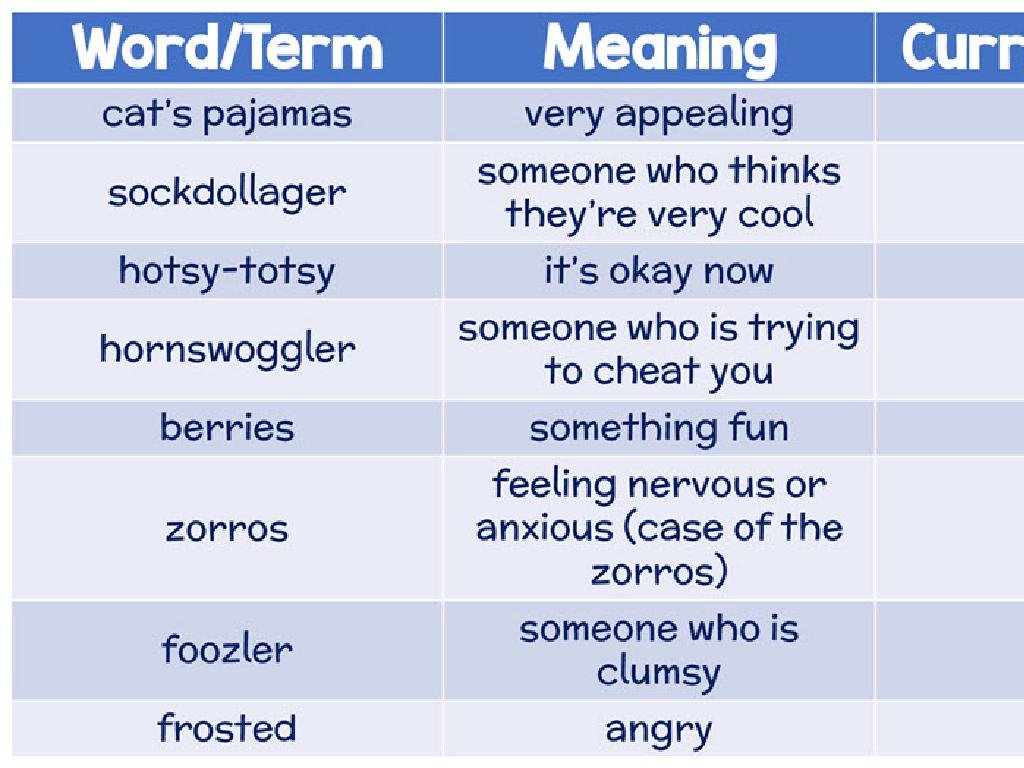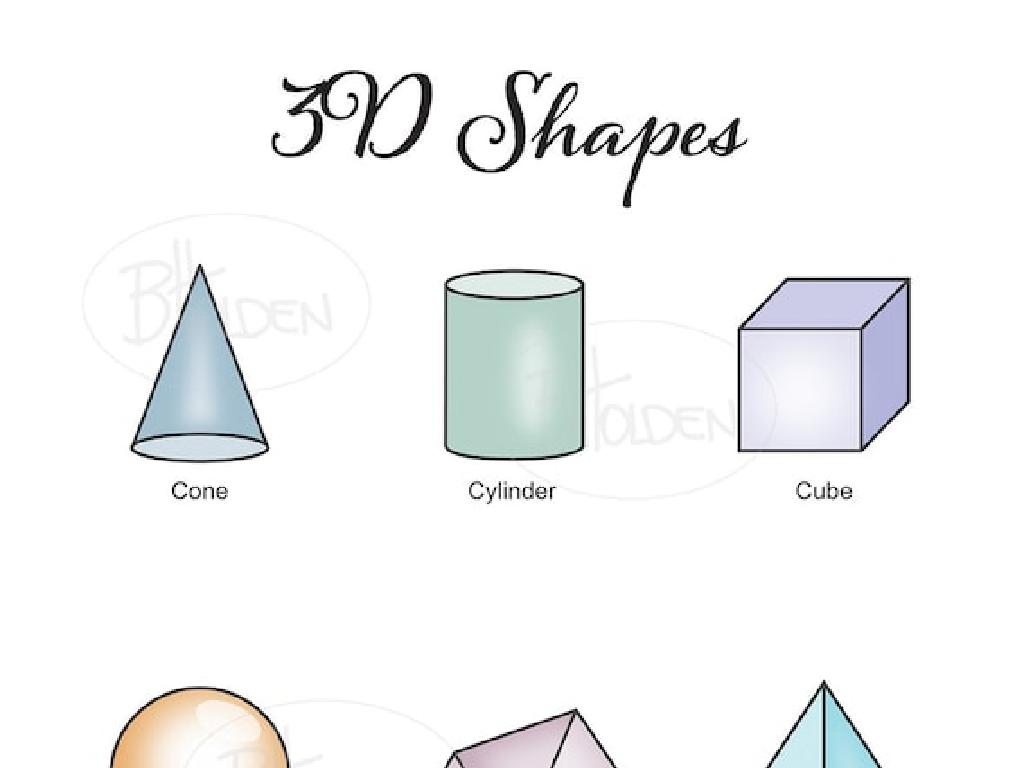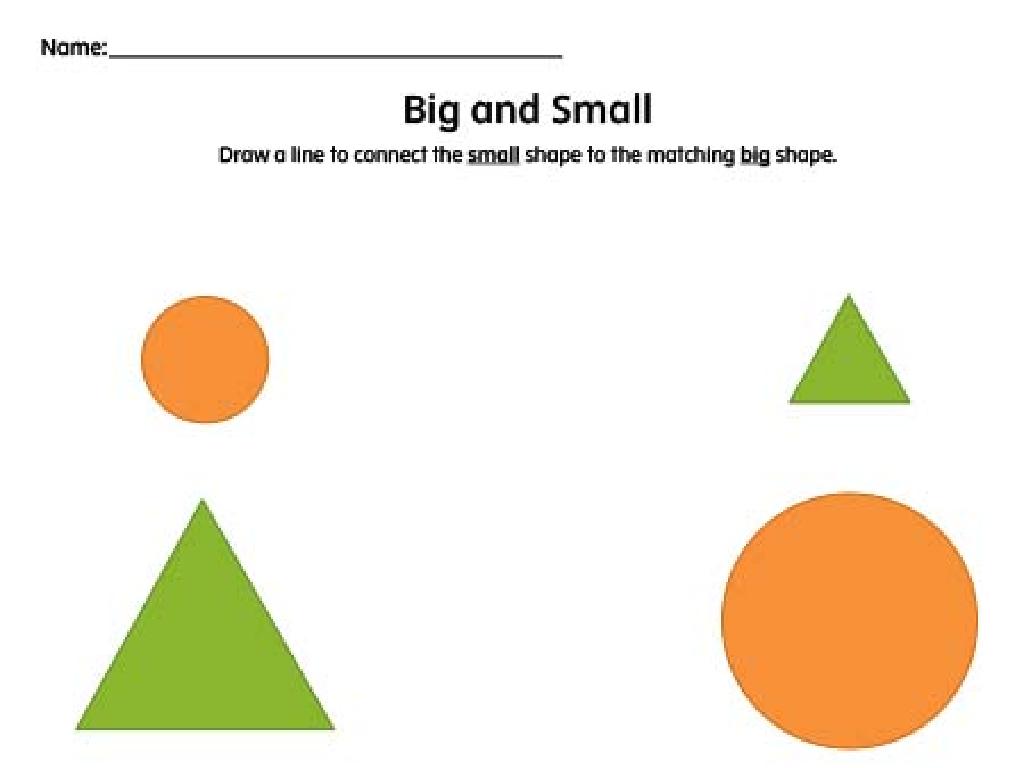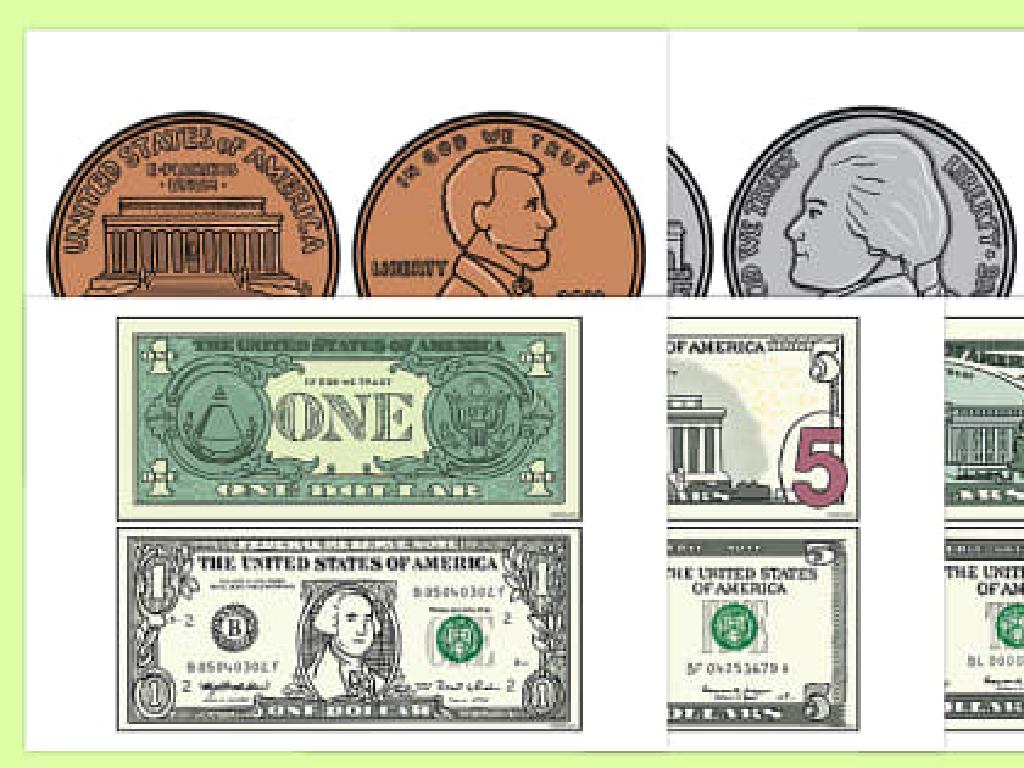Regular And Irregular Polygons
Subject: Math
Grade: Fifth grade
Topic: Polygons
Please LOG IN to download the presentation. Access is available to registered users only.
View More Content
Exploring Polygons: Regular vs. Irregular
– Polygons are 2D shapes
– Closed figures with straight sides
– Find polygons in everyday life
– Tables, clocks, and signs are polygon examples
– Regular polygons have equal sides
– Equal sides and angles, like a square
– Irregular polygons have different sides
– Sides and angles aren’t equal, like a kite
|
This slide introduces students to the concept of polygons, focusing on the distinction between regular and irregular polygons. Begin by defining a polygon as a two-dimensional shape with straight sides that are fully closed. Encourage students to look around and identify objects that have polygonal shapes. Then, explain that regular polygons have all sides and angles equal, such as squares and equilateral triangles, while irregular polygons have sides and angles of different lengths and degrees, like kites and rectangles. Use visuals of common objects to help students recognize these shapes in their environment. The goal is to help students understand and identify regular and irregular polygons in both geometric and real-world contexts.
Exploring Polygons
– Polygons are 2D shapes
– They have straight sides and are flat
– Must be a closed figure
– All the sides connect at endpoints
– Can be simple or complex
– Simple polygons don’t cross themselves, complex ones do
– Examples: Triangle, Square
– Simple: Triangle, Rectangle; Complex: Star, Spiral
|
This slide introduces students to the concept of polygons, emphasizing their two-dimensional nature and the requirement for having straight sides. It’s important to clarify that polygons must be closed figures, meaning all sides connect at their endpoints. Differentiate between simple polygons, which do not intersect themselves, and complex polygons, which do. Provide clear examples of each to help students visualize the difference. Encourage students to draw their own simple and complex polygons and to look for these shapes in their environment.
Characteristics of Regular Polygons
– All sides have equal length
– Like a square’s sides are all the same
– Each interior angle is equal
– Angles inside are all the same size
– Examples: triangle, square
– Equilateral triangle: all sides/angles equal. Square: four equal sides/angles
|
This slide introduces students to the concept of regular polygons, which are shapes with all sides and angles equal. Emphasize that regular polygons look ‘even’ or ‘balanced’ because of this. Use a square and an equilateral triangle as clear examples, as these are shapes the students are likely familiar with. Explain that in these shapes, not only are the sides the same length, but the angles between each side are also the same. This is what makes them regular. You can demonstrate this by measuring or using objects with equal sides. Encourage students to think of other shapes that might be regular polygons and to consider why shapes like rectangles are not regular polygons.
Exploring Irregular Polygons
– Sides of different lengths
– Not all sides are the same length
– Varying interior angles
– Angles are not equal
– Examples: scalene triangle, rectangle
– Scalene has no equal sides, rectangles have different length and width
|
This slide introduces students to the concept of irregular polygons, which are polygons with sides that are not all the same length and angles that are not all the same measure. Use a scalene triangle as an example to show that all sides and angles are different. A rectangle is another example where opposite sides are equal, but all sides are not equal in length. Encourage students to draw their own irregular polygons and identify the varying lengths of sides and angles. This will help them understand that irregular polygons do not have the same symmetry as regular polygons but are still an important category of shapes in geometry.
Identifying Polygons: Regular vs. Irregular
– Discover polygons in our world
– Characteristics of regular polygons
– Equal sides and angles, e.g., square
– Characteristics of irregular polygons
– Sides or angles not equal, e.g., rectangle
– Classify examples as regular or irregular
|
This slide aims to help students recognize and differentiate between regular and irregular polygons. Begin by exploring the environment to find various examples of polygons. Explain that regular polygons have all sides and angles equal, such as a square or an equilateral triangle. In contrast, irregular polygons have sides and angles that are not all the same, like rectangles or scalene triangles. Encourage students to classify given shapes as regular or irregular, reinforcing their understanding of the properties that define each category. Provide a variety of shapes for students to practice this skill.
Regular Polygons in Real Life
– Regular polygons in architecture
– Buildings often use shapes like hexagons for strength and aesthetics
– Symmetry in nature
– Flowers and snowflakes often show radial symmetry with regular polygons
– Regular polygons in objects
– Items like stop signs (octagons) and tables (squares or hexagons)
– Understanding polygon shapes
|
This slide aims to show students how regular polygons are not just mathematical concepts but are also present in everyday life. From the structures we live and work in, to the natural world around us, to the objects we use daily, regular polygons are everywhere. Highlight examples such as the Pentagon building (pentagon shape), honeycomb structures (hexagons), and the symmetry in a snowflake. Discuss how recognizing these shapes helps us understand and appreciate the geometry in our world. Encourage students to find and bring examples of regular polygons they observe in their environment.
Irregular Polygons in Real Life
– Irregular polygons in art
– Artists often use irregular shapes for creativity and expression.
– Everyday objects with irregular shapes
– Tables, frames, and tiles can have irregular polygonal shapes.
– Irregular polygons found in nature
– Leaves, flowers, and snowflakes often show irregular polygonal patterns.
– Understanding irregularity in polygons
|
This slide aims to show students that irregular polygons are not just mathematical concepts, but they are also present in our daily lives. Start by explaining that unlike regular polygons, irregular polygons do not have all sides and angles equal. Show examples of irregular polygons in art, such as abstract paintings or sculptures, to illustrate how they are used for aesthetic purposes. Then, move on to identifying irregular polygons in everyday objects like furniture or architectural elements. Discuss how nature is full of irregular polygons, with examples such as the shapes of leaves or the structure of snowflakes. Encourage students to look for and recognize irregular polygons in their surroundings, reinforcing the idea that math is closely connected to the world they interact with every day.
Drawing Polygons: Regular and Irregular
– Steps to draw a regular pentagon
– Start with a circle, mark 5 equal points, connect them.
– Drawing an irregular hexagon
– No equal sides or angles, sketch freely.
– Use rulers and protractors for practice
– Measure sides with rulers, angles with protractors.
– Activity: Polygon drawing exercise
|
This slide is aimed at teaching students the techniques to draw regular and irregular polygons. For a regular pentagon, they should learn to divide a circle into five equal parts and connect the points to form the shape. When drawing an irregular hexagon, emphasize creativity and the absence of constraints like equal sides or angles. Encourage the use of rulers and protractors to practice precision in drawing straight lines and accurate angles. The class activity will involve hands-on practice where students will draw both regular and irregular polygons using the tools mentioned. Provide guidance on using the protractor correctly and ensure each student can measure and draw angles confidently.
Class Activity: Polygon Scavenger Hunt
– Find polygons in the classroom
– List regular and irregular types
– Regular polygons have equal sides and angles, like a square. Irregular ones do not, like a trapezoid.
– Draw or describe their locations
– Share findings with the class
|
This activity is designed to help students identify and differentiate between regular and irregular polygons in a fun and interactive way. Encourage the students to look around the classroom for real-life examples of polygons, such as windows, tiles, or pictures. They should make a list of the shapes they find and note which are regular (all sides and angles equal) and which are irregular (sides and angles not all equal). Students can either draw a rough sketch of where they found the polygons or write a brief description. After the hunt, ask the students to present their findings to the class, fostering a collaborative learning environment. This will also help them practice their communication and observation skills.
Conclusion: Regular vs. Irregular Polygons
– Recap: Regular vs. Irregular
– Regular polygons have equal sides and angles. Irregular polygons do not.
– Importance of Polygon Knowledge
– Knowing polygons helps in geometry, art, and understanding shapes around us.
– Next Class: Polygon Properties
– We’ll explore sides, angles, and why they matter.
– Review and Questions
|
As we wrap up today’s lesson, remember that regular polygons have all sides and angles equal, while irregular polygons have sides and angles that are not equal. Understanding the difference is crucial as it lays the foundation for more complex geometry concepts. Recognizing and classifying polygons is not only important in math but also in real life, as it helps us identify and describe shapes we see every day. For the next class, students should be prepared to delve into the specific properties of polygons, such as the sum of interior angles and the relationship between sides. Encourage students to review today’s material and come with questions for a deeper understanding.






